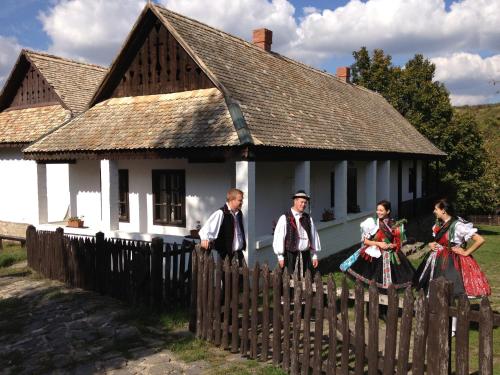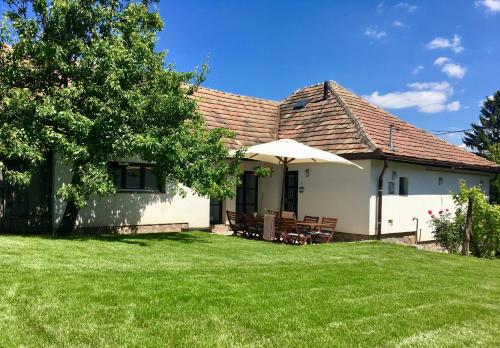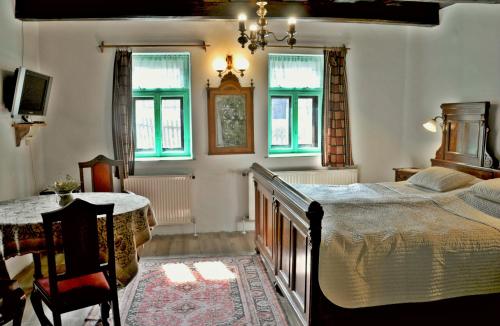Travelling through the countryside, travelling through time. On a day trip from Budapest to the small village of Holloko in Hungary, I’m transported to a period before modern machinery.
The village, home to farmers for generations, has been preserved just how it was before the agricultural revolution of the 20th century – small wooden houses, fields around the settlement, barns on the edge of town.
To visit Holloko, to walk down its main street and pop into the buildings that are now open as shops, restaurants, or museums, is to visit the rural Hungary of at least a century ago.
It’s quaint in appearance but underdeveloped by the standards of many other parts of Europe at the time – partly because the continent’s power brokers didn’t want to invest in infrastructure in the region.
I’ve got more information further down about how to visit Holloko from Budapest independently. If you would prefer to take the hassle out of the day, this Holloko day trip will arrange everything for you.
When you explore Holloko, you’ll see a village of yesteryear. But, remember, it’s still inhabited, and not some kind of historical theme park, so of course it now has modern conveniences like electricity.
The history of Holloko
The first houses of this village of Holloko appeared about 350 years ago, towards the end of the 17th century. Before that, there had been a settlement in the same area, to support the hilltop castle founded in the Middle Ages – more on that shortly.
That previous village was abandoned and destroyed. (Obviously the castle that had been built to protect the village didn’t work every time!) And the new one was settled by farmers from the Paloc ethnic group.
Holloko began as just a single street and, following the tradition at the time, houses were built down the street on either side, the entrances facing each other and the land behind the houses belonging to each resident.
As the next generations of Paloc grew up and needed their own homes, they built houses at the back of their family plot, gradually expanding the village out that way.
Because the residents of Holloko built their houses from wood (disobeying an official decree in 1783 that forbade wooden buildings), fires were common and many houses burnt down over the years (which was the reason for the decree, by the way).
And, so, although the style remained consistent, most of the houses in Holloko are not original ones from the 17th century and have been rebuilt at some point – or at many points. However, the last serious fire in the village was in 1909, so few homes are more recent than that.
But what’s particularly interesting is that, even when Hungary went through its agricultural revolution after the Second World War and many places, previously subjugated, began to modernise, Holloko didn’t.
The Paloc residents wanted to preserve their history and the strong community they had built. They protected their homes, didn’t give into the temptation of a modern global Europe, and it’s for this reason that Holloko was able to be declared a World Heritage Site in 1987.
Now, there are about 380 residents living in Holloko, both in the historic main street and in some more modern houses at the entrance to the village.
Things to see at Holloko
Exploring the centre of the village of Holloko can be as simple as walking down the main street in one direction, turning around, and coming back again. There’s just one small section where a second road breaks off and runs alongside the main road before rejoining it after about 100 metres.
This gives you a good sense of Holloko – how it’s laid out, what the houses look like, the atmosphere of this small rural community.
Together, the white-washed buildings create a lovely tableau, but be sure to notice the details of individual characteristics of each one. Their stone bases, verandas at the front with overhanging covering, wooden balustrades, and sloped tiled roofs.
You can even stay overnight in some of the homes in Holloko. Further down this story, I’ve got some tips on the best accommodation in Holloko.
But beyond exploring the village, there are a few particular Holloko attractions that I want to mention and that you might like to include in your visit.
If you start at the visitor centre at the main carpark, you’ll be able to pick up a map (not that you’ll get lost) to help show you where these places are.
St Martin Church
The most prominent landmark in Holloko is St Martin Church, named for the village’s patron saint, and built here in 1889. It sits at one of the two intersections of the historic part of the community.
The most prominent part of the Catholic church is the wooden shingled tower, dar brown in colour, that contrasts with the white base.
The building was originally a granary before being turned into a church and you should be able to poke your head in and have a look at the basic but charming interior that’s often the focus of village life.
Village Museum
There are a few museums in Holloko but the main one is simply called the Village Museum. It’s full of cultural and heritage items showing the story of life here.
The museum is a preserved house from the early 20th century that hasn’t been modernised internally like other residences. It presents a home of a young middle-class family with parents, a child, and a grandparent.
Other houses you may go into – like shops and restaurants – have all been altered, so this is a worthwhile insight into Holloko’s history.
Entry is Ft 400 (US$1) for adults and 250 Ft (US$0.65) for concessions.
Post Museum
This small museum is spread across just two rooms and tells the story of the postal service here and how that was used to represent the traditional culture.
On display are postcards, stamps, and banknotes that illustrate local landscapes, Paloc costumes, and other cultural imagery.
It may seem quite niche and you won’t be missing out on a major attraction if you skip it, but there’s a lot of detail here.
Entry is Ft 600 (US$1.55) for adults and Ft 300 (US$0.75) for concessions.
Paloc Doll Museum
Depending on when you visit Holloko, you won’t always get to see a lot of folk costumes – people usually just wear normal clothes. But the large dolls at the Paloc Doll Museum are dressed in colourful traditional dresses that will show you how they look.
There are more than 200 porcelain dolls on display, and there are also sometimes exhibitions of other Hungarian costumes.
Entry is Ft 400 (US$1.05) for adults and 200 Ft (US$0.50) for concessions.
Weaving House
One of the most important traditional industries in Holloko, other than agriculture, of course, was weaving. At the Weaving House, you can learn more about it.
A woman in a traditional costume will explain the history of manual weaving and demonstrate how to use one of the large wooden machines. There are also lots of different works on display, like embroideries and lacework.
Entry is Ft 400 (US$1) for adults and 250 Ft (US$0.65) for concessions.
Forest Trail
From anywhere within the village, you’re not far from nature, and if you’ve got time you can head off on a bit of a hike through the countryside.
But the simplest walk is just a short one called the Forest Trail that begins at the top of the main street, heads out through the trees, and arcs back to finish towards the end of the street.
The path takes you over some small rivers and amongst a couple of different types of foliage. There are signs pointing out some of the local flora and fauna, and it’s an easy and fun stroll for any age.
Holloko Castle
Other than the village itself, the most important thing to see in Holloko is the castle. Holloko Castle is on a hill above the settlement and is still a formidable sight.
Construction started in the middle of the 13th century and the original use for Holloko Castle was to protect against Mongol attacks. It was captured about 300 years later, in 1552, by the Ottomans and control alternated between them and the Hungarians until it was abandoned about 150 years later.
You can go inside the castle and climb up to the top of the keep for spectacular views across the fields and forests of the countryside. Although it’s in a slight level of disrepair, the condition is still pretty good and there are plenty of rooms with things on display.
You’ll find the weapon room, with swords and other pieces of warfare; there’s the chapel that was also used as a mosque during the Ottoman period; and the waxworks museum, with a rather eerie display of the castle’s lord and his family with their guests.
There’s a short path leading from the end of the village’s main street up to the castle, or an alternative way to reach the fortification is with a longer trail from the parking lot that goes through the forest. You can go one way and back the other, to create a route that loops through all of Holloko’s main sights.
Entry to Holloko Castle is Ft 900 (US$3) for adults and Ft 600 (US$2) for concessions.
Events in Holloko
The village may be historic but the people who live here today are as modern as you or me. Don’t expect them to be dressed up in folk costumes, for instance – most people you’ll meet in Holloko will be wearing whatever other people in rural Hungary wear.
But there are certain festivals throughout the year in Holloko where the heritage and customs are celebrated. If you can time your visit with one of these periods, you’ll get a lot more out of the experience.
Holloko Easter Festival
The Easter Festival in Holloko runs from the Saturday until the Monday. It’s the biggest celebration of the year, with most of the residents putting on their ornamented folk clothes for various events.
As well as food stalls, craft displays, and concerts, you’ll find special Hungarian Easter events like water pouring and egg painting.
Pentecost in Holloko
Pentecost is another important religious day for the residents of Holloko. The Christian event is celebrated 50 days after Easter Sunday and, once again, the traditional folk costumes come out.
There are lots of cultural events throughout the village and visitors are welcome to join.
Castle Tournament
The Holloko Castle, a symbol of the village, comes to life at the Castle Tournament in August. Expect medieval costumes and events, with plenty of food to keep you going through the day.
Harvest Festival
On the second Saturday of October, Holloko celebrates the Harvest Festival – a big event considering how important agriculture is to the community here.
There are parades through the streets, concerts, craft stalls, and lots of other interactive events. Unlike many of the other festivals that have religious elements, this one is purely about fun.
St Martin’s Day
Saint Martin is the patron saint of Holloko, so the village commemorates St Martin’s Day on November 11 each year.
The traditional food for the day is goose, so there are lots of opportunities to taste different goose dishes. Mulled wine is also a popular part of the festival (and perfect for this time of year).
Visiting Holloko from Budapest
Although there are lots of things to do in Budapest, it’s nice to do some day trips from the capital and Holloko is a great option. It’s easy enough to visit Holloko from Budapest either on a tour or independently by car. Public transport is a little trickier.
I’ve got some more information here to help you plan a visit.
Where is Holloko?
Holloko is about 95 kilometres northeast of Budapest, close to the border with Slovakia.
You can see it on a map here.
How do you get from Budapest to Holloko?
If you’re driving, it’s easy to get from Budapest to Holloko. Take the M3 and then turn left at Hatvan. The drive should take just over an hour.
By public transport, I would recommend you take one of the direct buses (2h 10m) from Budapest Stadion bus station – but you need to plan because they only leave a couple of times a day. Check the timetable here.
Otherwise, the next best option is to go from Újpest-Városkapu bus station to Szécsény on bus 1010 and transfer to another bus, 3355, to Holloko. The whole journey will take about 2h 30m.
Are there tours to Holloko?
To avoid the hassle of the tricky public transport, another option is to take a tour. Not only will the travel be much easier and more comfortable, but you’ll have a guide who can tell you more about the village.
I would suggest this tour to Holloko, which is run by a reputable Budapest tour operator. It’s only really affordable if there is a group of you, though.
How much does it cost to visit Holloko?
Visiting the village itself at Holloko is free. You can wander through the street(s) and see all the houses, pop into shops, and go for a hike without any cost.
The individual attractions at Holloko do have entry fees, though, like the castle and the museums. But none of them is particularly expensive so it’s still a cheap trip even if you go into most of the sights.
In total, there are 67 buildings in the Old Village of Holloko that are officially protected as a World Heritage Site. Around them are the farming areas, orchards, vineyards, meadows, and woods.
You could visit for just one hour and get a decent sense of Holloko, but I would suggest spending a few hours here to visit some of the museums, go for a walk in the forest, and have a meal at a restaurant.
To get a complete experience, you could even stay overnight in one of the houses that offer tourist accommodation. Not only will you get to know a bit about life here, you’ll see the village without all the visitors.
THE BEST ACCOMMODATION IN HOLLOKO
Staying overnight in Holloko is a wonderful way to experience the village and there are some lovely homes waiting to welcome you.
OPTION ONE

Right in the centre of town, the authentic Hollóköves Vendégházak has a variety of rooms to suit any size of group.
OPTION TWO

If you would like a whole home to yourself, Rákóczi12 Vendégház has two bedrooms, a hot tub, and a garden.
OPTION THREE

Just a few minutes’ walk from the historic centre, Kaláris Vendégház is a one bedroom apartment with great views.
OPTION FOUR

For the best location right in the centre of town, Nefelejcs Vendégház Hollókő is a comfortable two-bedroom apartment.
Great post and an interesting read. We love to explore World Heritage Sites and Holloko, Hungary seems like an ideal off the grid location to spend a couple of days.
We didn’t get to this village. It looks great. We have been to Hungary 3 times; communist 1975, post liberation1995 and modern 2007. Great differences. All fascinating. The medieval quarter of Sopron was a good place, as was Budapest. World Heritage Puszta is worth exploring.
Traveling is very important for a person, as it positively affects the general condition and allows you to reboot. Especially trips to the village, where you can breathe fresh air and relax from the bustle of the city.